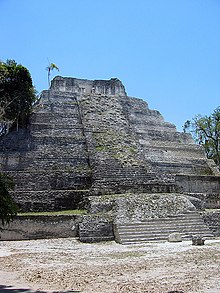Yaxha
Coordinates: 17 ° 4 ′ 20 ″ N , 89 ° 24 ′ 0 ″ W.
Yaxha (also Yaxhá written) is a Mayan site in the department of Petén in northern Guatemala . It was one of the most important cities of the classical Maya period and had its peak between 700 and 900 AD.
location
Yaxha is a classic Mayan site located between the two lakes Sacnab and Yaxha.
Yaxha is in the research area of the Triángulo Cultural. With 300 workers and 12 scientists, this “cultural triangle” is the largest research project in the Maya world. This is the first time that a geographical area of 1,200 km² is being examined and documented. It consists of the three huge centers Yaxha, Nakum , Naranjo and 13 sub-centers.
The Yaxha-Nakum-Naranjo National Park is an insider tip in the Maya world. It is part of the Biósfera Maya nature reserve . In the west it borders on the Tikal National Park, in the north on the Corredor Biológico Tikal - El Mirador - Rio Azul and in the south and east on the Zona de Usos Múltiples.
On the opposite side of Lake Yaxha is the Topoxté peninsula , the only site in Peten with upright post-classical architecture.
Description of the site
The Maya name of the site is expressed in its emblem hieroglyph, which represents the head of a parrot. It is pronounced Yax [jasch] Ha, which means green-blue water. The urban area was populated for 16 centuries (600 BC - 900 AD).
The most important complexes include the Royal Palace, where the ruler lived with his family, the North Acropolis, the Astronomical Complex, two ball courts, the East Acropolis, the Painter Complex and the Twin Pyramid Complex. All of them are tied into a system of cobbled and sacred streets.
On the outskirts, craftsmen, farmers and servants lived in simple huts made of wood or adobe (a mixture of earth, clay and water) with palm roofs. Only the stone foundations are evidence of their dwellings. It is therefore difficult to estimate the number of inhabitants. But the population of Yaxha in its heyday (700-900 AD) is estimated at 35,000 people.
Important water resources have been preserved in the park. These include lagoons, streams and water reservoirs. Some of them were created by the Maya . You will find a great variety of birds, mammals, reptiles and insects as well as a lush flora in the national park.
Various forms and types of ceramics were found in Yaxha, which were used for ritual acts and for household use. The production of plates, mugs and bowls with multicolored patterns reached its peak in the classical period. The pictures mostly depicted mystical or historical scenes. Vessels decorated with hieroglyphs were also found . These explain their ceremonial use and include the name of the craftsman who made them.
astronomy
The Maya observed the course of the sun from sunrise to sunset and its position at the zenith . The two astronomical complexes (place F and C) are arranged in such a way that the angle of incidence of the sun falls on a certain point of the building on certain days of the year, in particular on the solstice and the equinox . The time was precisely calculated by the Maya and recorded in calendars that were used for agriculture and ceremonies.
financing
In 1989 the first excavation and restoration work began in cooperation with the KfW ( Deutsche Kreditanstalt für Wiederaufbau ). The financial aid provided by KfW extended over 16 years and ended at the end of 2005. In 2006, only additional measures took place, such as B. the restoration of the palace 218.
From 2002 to 2007, funds from the BID ( Banco Interamericano de Desarollo ) also flowed into the site, with clear differences between the reconstruction work carried out by KfW and the BID.
watch TV
Shooting has already taken place several times in Yaxha.
In 2005, the site was the location for the reality show " Survivor Guatemala" on the North American broadcaster CBS .
In March 2007 a team from Spiegel TV filmed in Yaxha.
literature
- Dieter Richter: Experience Maya culture . Reise Know-How, 2003, ISBN 3-8317-1085-6
- Joyce Kelly: An Archaeological Guide to Northern Central America: Belize, Guatemala, Honduras, and El Salvador. Univ. Of Oklahoma Pr., Norman 1996, ISBN 0-8061-2858-5 , pp. 114-120.
Web links
- Scientific documentation of the largest Mayan research project
- General site for an introduction to the architectural styles of the Maya region
- Page with animations of the island of Topoxté
- Society for the Protection of Archaeological Sites in Petén ( Memento of December 22, 2010 in the Internet Archive )
swell
- Publication of the Yaxha-Nakum-Naranjo National Park
- Café Arqueológico Yaxhá, Flores, Guatemala





